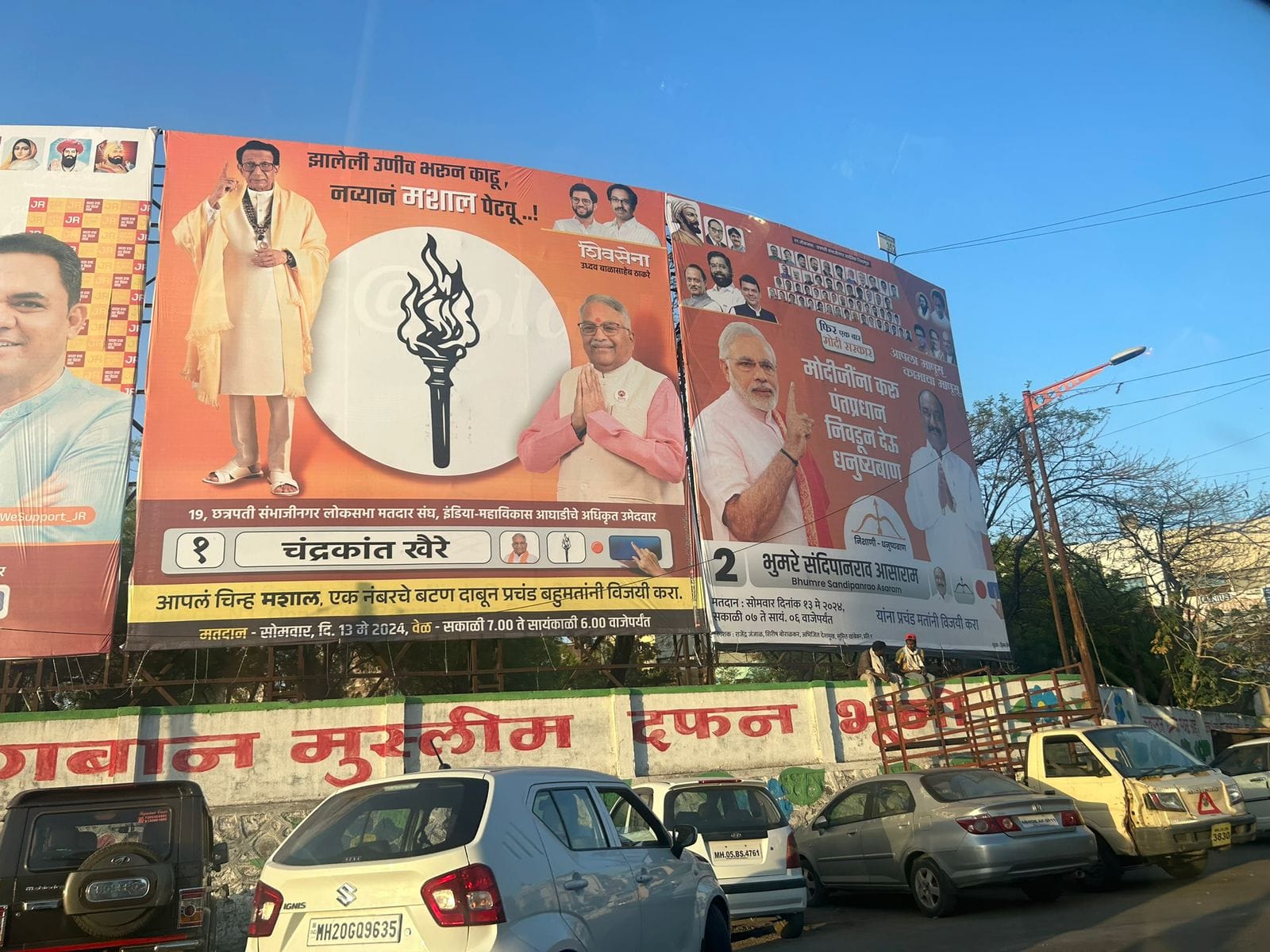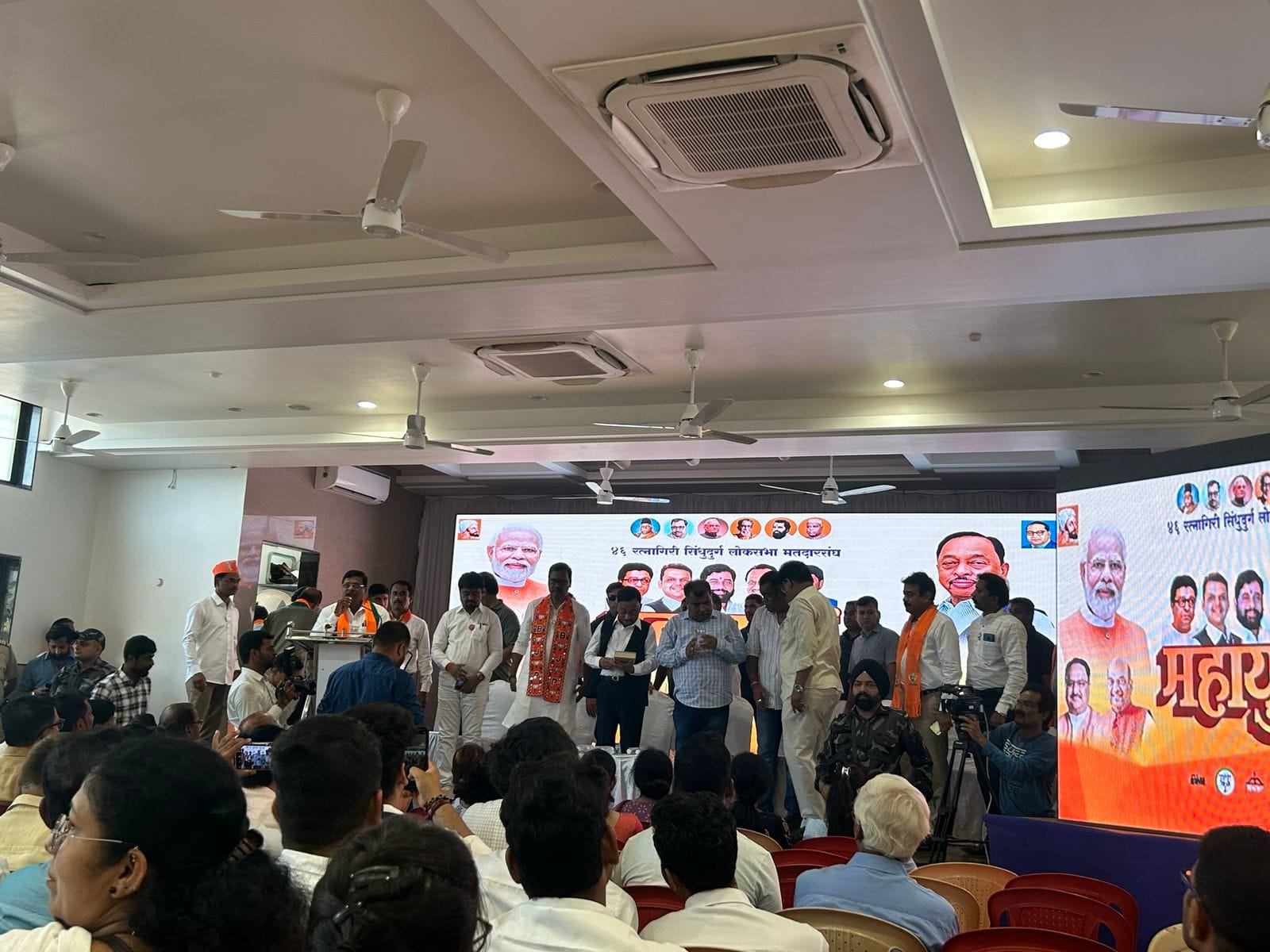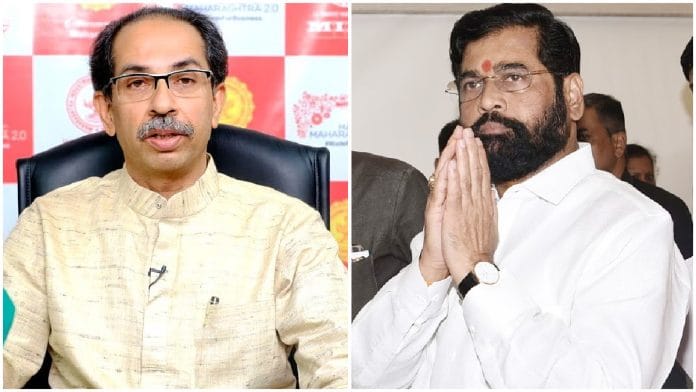Mumbai/Ratnagiri/Chhatrapati Sambhajinagar: At a huge makeshift camp set up last week to campaign for Chandrakant Khaire — the Shiv Sena (Uddhav Balasaheb Thackeray) candidate for Chhatrapati Sambhajinagar (formerly Aurangabad) Lok Sabha seat — former city mayor Nandkumar Ghodele was overseeing the arrangements for the day. He paused briefly to stretch, and said, “The leaders may have gone with Eknath Shinde, but the entire ground cadre is with us.”
About 5 km away, the candidate of the Eknath Shinde faction of Sena for the constituency, Sandipan Bhumare, was getting ready to head for a campaign meeting to be addressed by Chief Minister Shinde himself. “The ground cadre is taken care of by the local leader. If the local leader decides to leave, why will the cadre want to stick around?” he remarked.
The truth about what has transpired since the split in the Shiv Sena, nearly two years ago, lies somewhere in the middle. Both sides have won some and lost some.
The Shinde-led Sena, which saw support from a majority of key MLAs and MPs, happened to gain several ground workers associated with them, besides some important party leaders. It also bagged the official tag of being the “real Shiv Sena” and the party’s symbol — the bow and arrow — which might help it garner a few extra votes due to its familiarity among the electorate.
Shiv Sena (UBT), on the other hand, has managed to retain a key shelf of the party’s administration, comprising senior and experienced functionaries with political acumen, leaders from both sides said. It has also managed to maintain a sentiment of sympathy for the Thackeray clan, brewing in its strongholds like Mumbai, Thane and Konkan.
Both factions have spent the last two years trying to pare their losses, make appointments and build organisational strength, as they head into their first electoral tussle.
Of the 48 Lok Sabha seats in Maharashtra, there is a Sena vs Sena fight in 13. These include three of the six seats in Mumbai, and one seat in Thane — the undivided Sena’s original bastions — which will go to polls in the fifth and final phase of elections in Maharashtra Monday.
Within their respective alliances, both factions of the Shiv Sena were able to flex their muscles and get their way, optimising the seats they are now contesting. However, this election, there’s a lot at stake for both sides.
“In any party, the electoral and organisational wings don’t stay separate, but in the undivided Sena, there was a conscious effort to keep these two separate, especially after Narayan Rane’s rebellion,” Sanjay Patil, a researcher with Mumbai University, told ThePrint.
“There is a part of the Shiv Sena, for whom the legitimacy comes only from Matoshree, and the word ‘gaddari’ (betrayal) has a special connotation linked with ‘sanskaar’ (culture). So the loyal organisational structure has stayed with Thackeray, but anyone even slightly politically ambitious has switched over to Eknath Shinde. On one side, there’s loyalty, and on the other side, there’s resources — money and power,” he added.

Sena’s rank and file in Mumbai, Thane
Shinde had, in 2022, walked out of the Thackeray-led Maha Vikas Aghadi (MVA) government, which comprised the undivided Shiv Sena, the undivided Nationalist Congress Party (NCP) and the Congress, with a majority of MLAs in tow, toppling it. He then joined hands with the Bharatiya Janata Party (BJP) to form a government in the state.
In the first year post the split, there were sporadic tussles between the two factions over who had control of certain shakhas — the lowest administrative unit of undivided Sena’s structure. For instance, in November last year, there was much drama in Thane’s Mumbra, when Thackeray was shown black flags by the workers of Shinde’s Sena, when he tried to visit a local shakha. They also raised slogans against him. Thackeray had slammed the Shinde faction for unlawfully razing a shakha that belonged to his party.
The shakhas are the party’s public interface, and the office through which the party has been known to run a parallel system of governance in the state, especially in Mumbai.
A second leader from the Shinde-led Sena, who did not wish to be named, said that in Mumbai — a city, where the mass of the old Shiv Sena supporter base is still loyal to the Thackeray name — the party started focusing on setting up a network of shakhas almost immediately after the rebellion. By now, he said, the party has set up 227 shakhas, one in each of Mumbai’s councillor wards, just like the Shiv Sena (UBT).
“We had to identify office spaces, make fresh appointments. We had some workers from the ground cadre who shifted with us, but we also inducted workers from parties like the Maharashtra Navnirman Sena (MNS), Congress and NCP in large numbers,” he said.
He made it a point to add that even Sena (UBT) had to bring in some fresh blood to fill positions.
Pandurang Sapkal, a Mumbai-based functionary of Sena (UBT), who has been with the party for four decades, said that when undivided Sena started the work of setting up shakhas, it took at least five years in Mumbai, and 10 years in rural Maharashtra, to have them up and running.
“Our senior leaders toiled hard to establish these shakhas and popularise them among people. It’s not an easy task and can’t be done in just two years. All our shakhas, built years ago, are still standing, functioning and helping people, while several of the ones, that they (Shinde’s Sena) have built by leasing properties, have shut down today. Those that are still open don’t have many people going there.”
In Mumbai, the Shiv Sena (UBT) is contesting four seats, while Shinde’s Sena is contesting three. In Mumbai South, incumbent Shiv Sena (UBT) MP Arvind Sawant will fight Shinde-led Sena’s Yamini Jadhav. In Mumbai South Central, Sena (UBT)’s Anil Desai will take on sitting MP Rahul Shewale from the Shinde faction, while in Mumbai North West, Sena (UBT)’s Amol Kirtikar will contest against Shinde Sena’s Ravindra Waikar.
In Thane, another stronghold of the undivided Sena, the Thackeray camp has had to mirror the Shinde faction’s efforts in Mumbai. The party has worked hard to regain lost ground in a city that is CM Shinde’s home turf. Members of the Thackeray family have visited often, and the party has made appointments of key functionaries and tried to reach its support base door-to-door. Local leaders, however, had admitted to ThePrint last year that Thane, being CM Shinde’s bastion, is a challenge for the party, as the other faction is in control of the resources.
Thane holds a special importance in Shiv Sena’s history as the party secured its first political victory here in 1967, when it won 17 out of 40 seats in civic polls. Late Sena leader Anand Dighe, who Shinde calls his mentor, is largely credited with expanding the party’s roots in Thane and its neighbouring regions, including Kalyan, Dombivli, Ambernath, and Bhiwandi. Dighe is said to have groomed Shinde, and after his death in 2001, Shiv Sena’s expanse in Thane became Shinde’s fiefdom.
As the two Senas lock horns in the constituency with sitting Sena (UBT) MP Rajan Vichare contesting against Shinde camp’s Naresh Mhaske, the narrative is as much about the successor of Dighe’s legacy as it is about who will inherit Bal Thackeray’s legacy. Despite it being Shinde’s home turf, Sena (UBT) is confident of its own base in the region.
Speaking to reporters last week, Vichare had said that in 2019, Shinde had diverted all his machinery in Thane to campaign for his son, Shrikant Shinde, in Kalyan, where he won without Shinde’s help.
Also Read: Saurashtra, Patidar & ‘Zamindar’— what’s fuelling Rajput fury against BJP’s Rupala in ‘Gujarat Garh’
Political might vs organisational experience
A senior leader, who shifted to the Shinde faction from Sena (UBT) almost a year after the split, said that initially, the rebellion came as a shock.
“When the split occurred, I, as a karyakarta and leader, thought that they would patch up. It was unbelievable that something like this could happen. Gradually, over time, we understood that Eknath Shinde’s reasons were strong, while some were personal too. He wasn’t allowed to perform as a minister, and there was a lot of interference by the Thackeray household,” the leader said.
She said that much like her, many party workers were in wait-and-watch mode, and gradually shifted to Shinde’s party. However, according to her, what the Shinde-led Sena still lacks today is a “rich cadre of experienced administrators — people who have spent three decades engaged in the party’s organisational work, and those who can be trusted as sampark pramukhs (communication chiefs) of districts”.
In Chhatrapati Sambhajinagar — where undivided Sena first established its Hindutva plank in electoral politics on a large scale, after winning the Vile Parle bypoll in Mumbai in 1987 by endorsing the same ideology — three of the four Shiv Sena MLAs rebelled with Shinde. The former Shiv Sena MP, Khaire, who has served four terms as a parliamentarian and built the foundation of the party’s politics in the city on the Hindutva fulcrum, however, stayed with Thackeray. The cadre and followers were accordingly divided.
Shinde camp’s leaders from Chhatrapati Sambhajinagar lament the fact that organisationally strong leaders, such as Ambadas Danve, who is now the Leader of Opposition in the state legislative council, stayed on with Sena (UBT). A party functionary of Shinde’s Sena even praised Danve as “one of the finest district chiefs the Shiv Sena has ever seen”.
Prashant Bansod Patil, another functionary from the Shinde faction in Chhatrapati Sambhajinagar district, said that the party’s cadre, who gets political and electoral work done, as well as a majority of the party’s former corporators in the city, have moved to Shinde’s side, along with the MLAs.
“But the shakha pramukhs and deputy shakha pramukhs haven’t come, mainly because they were never approached. That system collapsed as Shiv Sena, under Uddhav Thackeray, started taking most of the decisions at the leadership level, bypassing the shakha cadre. The system is idle today, attached to no one in particular. But if we don’t make active efforts to reach out to them, we will lose them to Thackeray,” he said.
It was this organisational cadre that Ghodele was referring to at Chandrakant Khaire’s makeshift campaign office.
In the coastal districts of Ratnagiri and Sindhudurg, the concept of rebellion is not new, but the sentiments attached to it run just as deep. The two districts became strongholds of undivided Sena as the party’s original ‘sons of the soil’ ideology in Mumbai hugely benefitted the youth from this region, who had migrated to the metropolitan city in large numbers in search of work.
Shiv Sena was stung by one of its bitterest rebellions here. In 2005, Narayan Rane, who hails from Sindhudurg, walked out of the party due to differences with Uddhav Thackeray, taking some of the party’s cadre with him to the Congress. He is currently with the BJP, and is contesting the Lok Sabha poll this time against Sena (UBT)’s Vinayak Raut.
The impact of Rane’s departure was seen in the next few elections. His son, Nilesh Rane, won the 2009 Lok Sabha elections from the Ratnagiri-Sindhudurg seat, and he won the Kudal assembly seat the same year. In 2014, however, Shiv Sena wrested not just the Lok Sabha seat from the Ranes, but the Kudal assembly seat, too, and retained it in 2019.

The Shiv Sena has benefitted from other rebellions in this belt after leaders, such as Uday Samant, Deepak Kesarkar and Bhaskar Jadhav, joined the party from the NCP in 2014. Now, Samant and Kesarkar are ministers in the Shinde cabinet, while Jadhav has stayed put with Thackeray.
Pradeep Salvi, who has been the Sena’s Ratnagiri taluka chief for 15 years, and is with Sena (UBT), said that Shinde’s rebellion has been a “no profit, no loss” for his party in the Ratnagiri-Sindhudurg belt.
Sitting at Ratnagiri’s ‘shakha no. 1’, Salvi said, “All those who had come from outside with Samant and Kesarkar are the ones who have gone with Shinde. No original Shiv Sainik has left. Look at me. People like me have stayed loyal.”
A lot at stake
Arvind Nerkar, a former MLA of the undivided Sena, who is among the most experienced organisational heads in Sena (UBT) — the kind that Shinde-led Sena’s leaders lament the dearth of within their party — said that there is undeniable sympathy for his party, and “justifiably so”.
He said that he went through an ailment similar to the one Uddhav Thackeray had to suffer and undergo a spinal surgery for. “The recovery is long and painful, and in such a situation, he (Thackeray) was criticised for not stepping out of his house as CM. In such a situation, Shinde was plotting against him. If this brand of politics continues, there will come a time when people won’t let a single politician stand before them.”
In the same breath, he, however, admitted that this election is “extremely important” and it is now “the question of their pride”.
For both sides, there’s a lot riding on the election verdict. The Shinde-led Sena negotiated 15 seats for itself in the Mahayuti alliance with BJP and Ajit Pawar-led NCP at the cost of causing friction with its allies. Its performance now will determine its bargaining strength in the state assembly polls, scheduled later this year.
The party also has the added advantage of getting the Shiv Sena’s original symbol of the bow and arrow.
“We have been running pillar to post trying to popularise the mashaal (flaming torch) symbol, but in the minds of a lot of voters, especially the seniors, the bow and arrow is the Shiv Sena. They say they want to vote for Uddhav Thackeray, but when we ask, which symbol will you press? They say the bow and arrow,” Pushpa Nalawade, city president for the Shiv Sena (UBT) in Chhatrapati Sambhajinagar, said.
Shinde’s Sena also has the ability to get pro-Narendra Modi votes. The prime minister’s work over the last ten years has been a major talking point for most candidates of the Shinde camp.
Meanwhile, Sena (UBT), which is contesting 21 seats, could get sympathy votes from its long-time supporters, especially in the party’s traditional strongholds of Mumbai, Thane and Konkan.
The possibility of it garnering sympathy votes is a genuine concern for Mahayuti leaders, who have been talking about how to tackle this issue in meetings with the ground cadre.
For instance, speaking at a karyakarta meet in Ratnagiri last month, BJP’s national general secretary said, “There’s always sympathy for the person who gets hit. If a bus hits a car, there’s sympathy for the car. If a car hits a scooter, there’s sympathy for the scooter, and if the scooter hits a cycle, there’s sympathy for the cycle. But, if you have to get your daughter married, you will not give her hand to the cycle driver out of sympathy.”
The election is a test for Thackeray’s Sena to see if it can draw anti-Modi and anti-BJP votes.
In an interview to his party’s mouthpiece Saamana Monday, Thackeray said he doesn’t accept the Election Commission or the speaker’s verdict recognising the Shinde-led party as the ‘real Shiv Sena’. He wants those decisions to be made in public court.
“It is my open challenge. We will give a date, we will call all the people of Maharashtra there. I will go and stand in the middle of the public. If the Election Commission has any courage, it should come, and this cunning person (Shinde) should come. In front of everyone, they should state who the party belongs to. Whatever the decision is, I’m willing to accept it.”
In a way, the election verdict on 4 June will do exactly that.
(Edited by Mannat Chugh)






